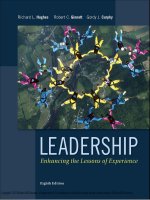Lecture Leadership: Enhancing the lessons of experience (4/e) – Chapter 12
Bạn đang xem bản rút gọn của tài liệu. Xem và tải ngay bản đầy đủ của tài liệu tại đây (396.62 KB, 12 trang )
121
McGrawHill/Irwin
© 2002 The McGrawHill Companies, Inc., All Rights Reserved.
C
HAPTER
T
WELVE
Contingency Theories of
Leadership
SLT Prescriptions For Most Appropriate
Behaviors Based On Follower Maturity
Relationship behaviors
Participating
(Lo T, Hi R)
Selling
(Hi T, Hi R)
Delegating
(Lo T, Lo R)
Telling
(Hi T, Lo R)
Task behaviors
M4
M3
M2
M1
Follower maturity
McGrawHill/Irwin
© 2002 The McGrawHill Companies, Inc., All Rights Reserved.
123
Components Of Follower Maturity
• Job maturity – the amount of task
relevant knowledge, experience,
skill, and ability that the follower
possesses.
• Psychological maturity – the
follower’s selfconfidence,
commitment, motivation and self
respect relative to the task at hand.
McGrawHill/Irwin
© 2002 The McGrawHill Companies, Inc., All Rights Reserved.
124
Factors From the Situational Leadership
Theory and the Interactional Framework
125
Leader
Telling
High task, low
relationship
Selling:
High task, high
relationship
Participating: Low task, low
relationship
Delegating: Low task, low
relationship
Decision to use developmental intervention
Outcomes:
Task accomplishment
Increased follower maturity (if
developmental interventions
used)
What is the task to be accomplished?
What is the followers’ job
maturity?
Psychological maturity?
Followers
McGrawHill/Irwin
Situation
© 2002 The McGrawHill Companies, Inc., All Rights Reserved.
Contingency
Theory
Leader effectiveness is primarily
determined by selecting the right kind of
leader for a certain situation or changing
the situation to fit the particular leader’s
style.
Motivational Hierarchies For Low
and HighLPC Leaders
127
People
Task
Task
People
LowLPC leader motivational hierarchy
HighLPC leader motivational hierarchy
McGrawHill/Irwin
© 2002 The McGrawHill Companies, Inc., All Rights Reserved.
Contingency Model Octant Structure For
Determining Situational Favorability
High
Task structure
Position power
Octant
McGrawHill/Irwin
Low
Overall situation favorability
Leadermember relations
Good
Structured
128
Poor
Unstructured
Structured
Unstructured
High
Low
High
Low
High
Low
High
Low
1
2
3
4
5
6
7
8
© 2002 The McGrawHill Companies, Inc., All Rights Reserved.
Factors From Fiedler’s Contingency
Theory and the Interactional Framework
Leader
Outcomes:
Motivation hierarchy
(as determined by LPC score)
Effective or
ineffective group
performance based
upon match or
mismatch between
leader and overall
favorability of the
leadership situation
Leader
member
relations
Task structure
Position power
Followers
McGrawHill/Irwin
Situation
© 2002 The McGrawHill Companies, Inc., All Rights Reserved.
129
Four Leader Behaviors of Path
Goal Theory
•
•
•
•
Directive
Supportive
Participative
Achievementoriented
McGrawHill/Irwin
© 2002 The McGrawHill Companies, Inc., All Rights Reserved.
1210
Interaction Between Followers’ Locus of Control 1211
Scores and Leader Behavior in Decision Making
External locus of
control followers
Internal locus of
control followers
Follower satisfaction with leader
High
Low
Directive
McGrawHill/Irwin
Leader behavior in decision making
Participative
© 2002 The McGrawHill Companies, Inc., All Rights Reserved.
Examples of Applying PathGoal
Theory
Situation
Leader
Followers
Newly formed
work unit
Directive
behaviors (tell
followers what
to do and how
to do it)
Reduced role
ambiguity
(clearer effort
to
performance
links)
Substandard
performance
(no rewards
for
performance)
Directive
behaviors
(make rewards
available and
contingent on
performance)
Clearer
performance
toreward
links
(increased
valence)
McGrawHill/Irwin
1212
Outcomes
Higher
effort
Higher
satisfaction
Higher
effort
Higher
satisfaction
© 2002 The McGrawHill Companies, Inc., All Rights Reserved.









